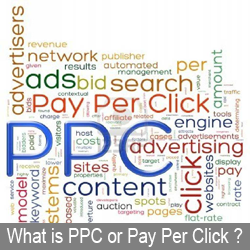 PPC, or Pay-Per-Click, is an Internet advertisement opportunity used to drive traffic to a website. PPC has proven to be an effective search engine marketing tool with many savvy site owners and SEO professionals. PPC ads can deliver immediate traffic, but for a price. It’s important to understand how PPC works and how to use it to ensure you get the most for your money.
PPC, or Pay-Per-Click, is an Internet advertisement opportunity used to drive traffic to a website. PPC has proven to be an effective search engine marketing tool with many savvy site owners and SEO professionals. PPC ads can deliver immediate traffic, but for a price. It’s important to understand how PPC works and how to use it to ensure you get the most for your money.The mechanism behind Pay-Per-Click marketing is simple. Search engines, like Google, Bing, and Yahoo, auction off ad space on their SERPs. These ads are usually found at the top and/or the side of the SERPs and are not mingled with the organic search results.
In the graphic below, we see the Google search results for “send big files.” The PPC ads are located in the top yellow box, and in the side bar area to the right. These companies-- ShareFile.com, YouSendIt.com, and DropBox.com (top); and Box.com, Huddle.com, LiveDrive.com, SyncPlicity.com, Exavault.com, and Mail.com (right side)--have all set up a PPC
campaign with Google Adwords and set a bid amount to pay when someone clicks on one of these links. The first organic or free result on this page is from TransferBigFiles.com, which is located below the yellow box of PPC ads in the white, main body portion of the results page.
For example, let’s say ShareFile.com, as an advertiser, has bid $.10 per click for this ad. If 100 people click on the PPC ad, ShareFile.com will pay Google $10.00 for these clicks, whether or not these site visitors end up buying ShareFile services. PPC is an attractive marketing tool because it generates almost immediate results. It can also be very expensive and not very cost-effective if you do not know what you are doing. A PPC ad may bring a lot of traffic, but that traffic may not be converted into profits. In order to make the most of PPC marketing, advertisers need to take a targeted approach and monitor results carefully. One of the best features of PPC campaigns is that they are very flexible. Advertisers can adjust or eliminate their PPC ads quickly if the ads are not producing the desired return on investment.
PPC is a great way for sites to gain instant traffic to their sites by becoming immediately visible for certain keywords. If a site owner has a new product or service, PPC can get the word out quickly and deliver visitors to a new site, but PPC should never replace good SEO. SEO efforts are long-lasting, while PPC lasts only as long as a campaign is actively running.
Also keep in mind that 80% of searchers still prefer to click on organic results (the ones in the white, main body in the graphic), rather than on PPC ads, so solid SEO practices will prove very beneficial in the long-term once pages are indexed and begin to rank higher on the SERPs.




















